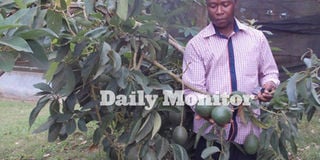How to graft quick - growing seedlings

Grafted trees bear fruit when they are still short. Dr Ssekabunga examines a grafted avocado tree. PHOTO BY Michael J Ssali
The farmers in Masaka region finally have a place to go to for clean improved coffee, mango, orange, and avocado plantlets.
Besides these, NARO-Kamenyamiggo Satellite Station located in Kingo Sub-county, Lwengo District has also set up an improved coffee seedling propagation and multiplication unit solely to supply clean, quick growing, and high yielding plantlets to interested farmers at affordable prices, according to Dr Nicholas Ssekabunga who took Seeds of Gold round the unit.
“The plantlets we supply at this unit are either cloned, like in the case of Coffee Wilt Disease (CWD) resistant Robusta coffee, or grafted like those for mangoes, avocado, and oranges or citrus fruit trees,” he said. “We have a mother garden for CWD resistant Robusta Coffee which we now encourage farmers to plant given the devastating CWD that has wiped out entire fields of the crop in this traditionally coffee growing area.”
Preferred
He defined grafting as one of the plant propagation technologies in which the upper part of one plant (known as the scion) is united with the lower part (called the stock) of another plant to form a new individual plant. He said the selected scion should have some leaves and buds to give rise to continued growth and fruiting of the new plant.
He further said that stocks with the preferred characteristics like growth vigour, disease resistance or drought tolerance, are used to come up with strong, fast growing and high yielding crops.
The plants that are easily grafted should be botanically closely related, for example different varieties of mangoes, different varieties of avocado or oranges and lemons. Right on display in the unit, are potted avocado seedlings with desirable characteristics ready to be used as stocks in grafting avocado plantlets.
Dicotyledonous groups of plants are the best for grafting. He said that if the scion is incompatible with the stock, the two will most likely fail to unite and the scion will eventually break away at a later stage. Successful grafting means total union of both the scion and the stock to make a new plant.
Dr Ssekabunga demonstrated how grafting of mango plantlets is carried out by making a slanting cut of the stock plant of one mango variety and making another slanting cut of the base of the scion of another mango variety before fitting the two pieces together and tying the two ends with grafting tape.
He said the two should be of the same diameter to have the best results. The scion should have some leaves which may be trimmed and safely covered with a small transparent polythene sheet to keep the scion moist and to facilitate healing and graft union formation. Dr Ssekabunga also clarified that there are several other methods of grafting, including what he called cleft grafting, bark grafting, and side grafting.
He said people seeking to become fruit farmers and to get out of poverty quickly must give due consideration to planting clean, vigorous, fast growing, and high yielding fruit tree plantlets. He further said that a farmer who plants an avocado seed may have to wait for close to six years before harvesting the fruits whereas the farmer who plants a grafted avocado could harvest fruits in less than three years. “The farmer has the advantage of harvesting the fruits without having to climb high up in the tree because grafted plants begin fruition when they are quite short.”
With the use of grafting technology it is possible to have two varieties of a fruit growing on a single stock. One branch may carry one type of mango while another branch carries another variety.
Grafting may be used to change fruit varieties. If a variety is no longer marketable the tree may be grafted with a variety that is on demand. It is also possible to repair damaged trees by cutting off a bad branch and replacing it with a healthy scion. Grafting also helps the farmer to propagate varieties that cannot be propagated easily by other means and to obtain special plant forms like tree roses.
Grafting may however fail if the scion and stock were not compatible.
It will also fail if either the stock or the scion is unhealthy. Care must be taken to ensure that both are obtained from clean and vigorous plant varieties. Failure to tie the graft area strongly or to cover the scion well may lead to the drying of the grafted plantlets.




